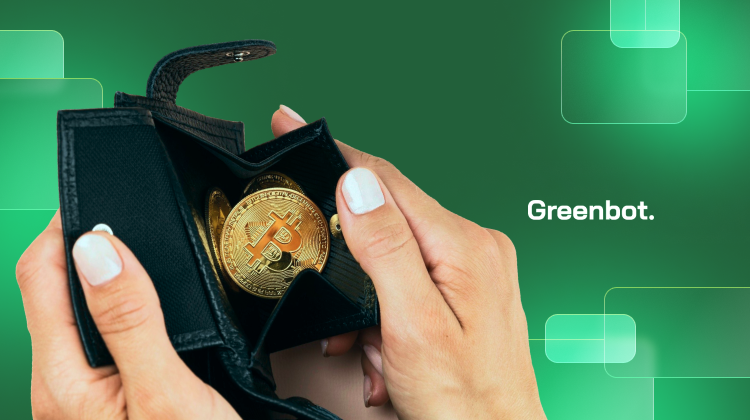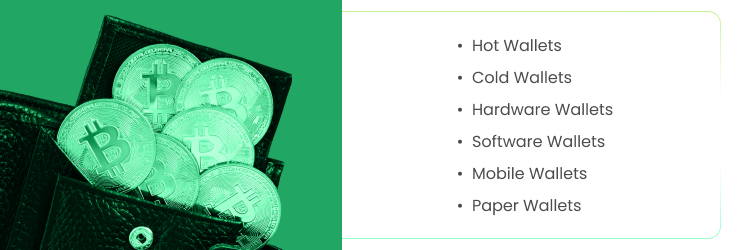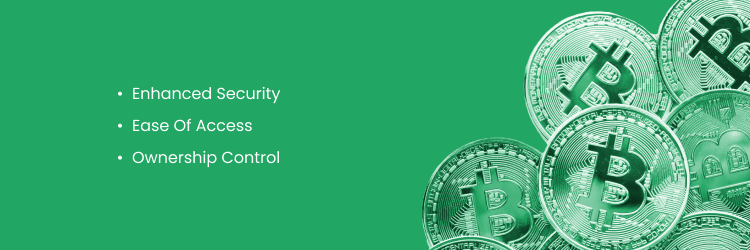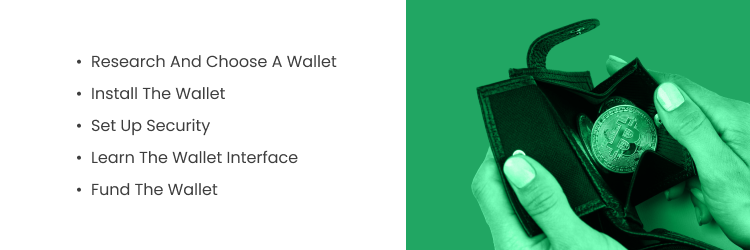
A crypto wallet is a digital tool for storing, sending, and receiving cryptocurrencies. It manages the private and public keys needed for cryptocurrency transactions. It acts as a gateway to blockchain networks. Without a wallet, users cannot access or manage their crypto assets.
The primary purpose of a crypto wallet is to safeguard private keys, ensuring that only the owner can allow transactions. Wallets simplify cryptocurrency management. They enable users to view their holdings, track balances, and interact with decentralized applications (dApps).
Crypto wallets are essential because they provide security and control over digital assets. If you’re an investor, trader, or dApp user, a wallet protects your funds from online threats. It gives you full ownership and accessibility, making it essential to understand what a crypto wallet is and how it ensures your digital assets remain safe.
What Is a Crypto Wallet?
A crypto wallet is a tool for securely storing and managing cryptocurrency. It uses two keys, a public key, and a private key, to access digital assets on the blockchain. It’s an essential tool for anyone using or investing in cryptocurrency.
Crypto wallets don’t hold your cryptocurrency directly. Instead, they provide access to your funds. The public key is like a bank account number used to receive money. The private key is like a password that you must keep safe to access and control your funds.
Crypto wallets are different from exchanges like Coinbase or Binance. Exchanges hold your private keys, so they control your funds. While exchanges are easy to trade, they don’t give you full ownership of your assets.
Non-custodial wallets let you keep control of your private keys and funds. These wallets give you more security and independence. This makes them a better choice for long-term storage or extra safety.
Examples of non-custodial wallets include Ledger Nano X, MetaMask, Exodus, and Trust Wallet. These options let you manage your cryptocurrency safely and easily.
How Do Crypto Wallets Work?
Crypto wallets manage your public and private keys. These keys are needed to interact with the blockchain. The public key acts as an address for receiving cryptocurrency. The private key is a secure code that allows you to access and control your funds.
When you send cryptocurrency, the wallet uses your private key to create a digital signature. This signature proves that you are the wallet owner and have authorized the transaction. The transaction is then sent to the blockchain network for validation.
Nodes on the blockchain network verify the signature to ensure it is valid. Once confirmed, the transaction is recorded on the blockchain, making it permanent and secure. This process prevents unauthorized access or tampering.
By managing these keys and facilitating secure transactions, crypto wallets provide a safe way to send, receive, and store digital currencies. They are a vital tool for anyone using cryptocurrency.
Types of Crypto Wallets

Cryptocurrency wallets come in different types. Each wallet offers unique features for managing digital assets. They are categorized based on how they store private keys and their connection to the internet. Below are the main types of wallets and their key characteristics.
Hot Wallets
Hot wallets are connected to the internet. They are ideal for frequent transactions or active traders. Online wallets offer quick access to funds but are more vulnerable to hacking. Examples include software wallets like MetaMask and Trust Wallet.
Cold Wallets
Cold wallets store private keys offline, offering the highest security level. They cut online hacking risks, making them ideal for long-term storage or “hodling” assets like Bitcoin. Examples include hardware wallets and paper wallets.
Hardware Wallets
Hardware wallets are physical devices that store private keys offline, providing robust security against online threats. They connect to devices like computers or smartphones only for transactions, ensuring private keys remain isolated. Popular options, such as the Ledger Nano X and Trezor Model T, support multiple cryptocurrencies and offer features like PIN protection and recovery phrases, making them ideal for securing digital assets.
Software Wallets
Software wallets are apps or programs installed on computers or devices. They connect to the internet for easy cryptocurrency access. Examples include Exodus and Electrum. While more secure than web wallets, they are still at risk of cyber-attacks.
Mobile Wallets
Mobile wallets are a crypto wallet app for smartphones or tablets. They offer convenience for on-the-go transactions. They provide quick access to funds and are great for frequent users. Examples include Trust Wallet and MetaMask.
Paper Wallets
Paper wallets are physical printouts of private and public keys, providing offline storage. They are secure from online threats but can be easily lost or damaged. Best for long-term storage, they are not recommended for frequent transactions.
Compare the Best Cryptocurrency Wallets
| Wallet | Features | Advantages | Best Use Cases |
| Ledger Nano X (Hardware) | Offline storage, multi-currency support, Bluetooth connectivity | High security, easy to use, portable | Long-term storage of crypto coins and for users concerned about security |
| MetaMask (Software) | Browser extension, Ethereum-focused, integrated with decentralized apps | Free, easy to use, seamless integration with dApps | Ethereum enthusiasts, active crypto traders, and decentralized app users |
| Trust Wallet (Mobile) | Multi-currency support, mobile-friendly, integrated with decentralized exchanges | Convenient, user-friendly, supports various cryptocurrencies | Mobile traders, everyday users |
| Exodus Wallet (Software) | Multi-platform support, built-in exchange, attractive UI | Beginner-friendly, visually appealing, supports multiple assets | Beginners, users managing diverse assets across devices |
Benefits of Using Crypto Wallets

Cryptocurrency wallets allow you to securely store and manage cryptocurrencies. They provide extra benefits, including enhanced security, easy access, and full ownership control. Here’s how these features make crypto wallets essential for managing digital currencies:
- Enhanced Security: Cold wallets store private keys offline, reducing hacking risks. Typically software wallets use encryption and 2FA for added protection. Regular updates help secure wallets against emerging threats. It ensures a safe environment for managing cryptocurrencies.
- Ease of Access: Crypto wallets provide quick access to digital assets from anywhere with an internet connection. Mobile and software wallets are user-friendly. Many support multiple currencies, simplifying asset management in one platform.
- Ownership Control: Bitcoin wallets give you full control of your private keys. They ensure complete ownership of your assets. This eliminates the need for third-party intermediaries. It helps protect your privacy and enables independent transactions.
How to Choose the Right Crypto Wallet
Choosing the right crypto wallet depends on your needs and how you plan to use it. If you’re trading, holding, or using different cryptocurrencies, the right wallet offers the security, features, and ease of use you need. Follow these steps to make the best choice.
- Define Your Needs: Decide how you’ll use the wallet. Hot wallets are great for frequent transactions, while cold wallets are better for long-term storage. Think about whether you need features like multi-currency support or dApp compatibility.
- Assess Wallet Security: Look for wallets with strong security features. These include encryption and two-factor authentication (2FA). Cold wallets, like hardware wallets, store private keys offline. They provide extra protection from hacking.
- Compare Wallet Features: Check what features the wallet offers. Some include staking, NFT storage, or simple interfaces. Look for backup and recovery options to protect your funds.
- Understand Compatibility with Coins: Ensure the wallet supports the cryptocurrencies you use. Multi-currency wallets are good for managing different assets. However, single-currency wallets may work better for specific coins.
- Look into Ease of Use and Support: Pick a wallet that’s easy to set up and use. Make sure it has good customer support and helpful guides for troubleshooting.
Getting Started With a Crypto Wallet

Following a few simple steps will help you choose, set up, and use a wallet safely. If you’re a beginner or an experienced user, these steps will help you get started with ease.
- Research and Choose a Wallet: Decide between hot wallets for quick transactions and cold wallets for long-term security. Consider your technical skills and needs. Look for wallets with strong security features, good customer support, and guides like tutorials or FAQs.
- Install the Wallet: Download software wallets only from official sources like app stores or the provider’s website. For hardware wallets, buy from trusted retailers to avoid counterfeit products. Follow the installation instructions specific to your wallet type to ensure a safe setup.
- Set Up Security: Create a strong password and back up your recovery phrase (12–24 words) on paper. Avoid storing it digitally. For extra protection, enable features like 2FA or biometric security, depending on your wallet’s capabilities.
- Learn the Wallet Interface: Take time to understand how the wallet works. Explore features like balance tracking, transaction history, and asset management. If your wallet supports staking or NFTs, familiarize yourself with these functions. This will help you use the wallet effectively.
- Fund the Wallet: To fund your wallet, transfer cryptocurrency from an exchange or another wallet. Use your wallet’s public address, and double-check it before sending. Keep in mind that blockchain transactions cannot be reversed. Start with a small amount to test the process.
How AI Is Shaping The Future Of Crypto Wallets
Artificial intelligence improves crypto wallet security by using fraud detection and behavioral biometrics to stop access. These tools watch the activity in real time to ensure only the owner can use the wallet. AI helps with risk management by finding cons and suggesting fixes to improve security.
AI offers personalized recommendations for choosing wallets and planning investments. By studying user behavior and market trends, it suggests the best wallets and the right time for transactions. Predictive analysis makes managing digital assets easier by making smarter decisions.
AI simplifies wallet management through automation and natural language interfaces. Automation handles repetitive tasks and multiple wallets. AI-powered assistants guide users through setup, troubleshooting, and wallet features. This makes crypto wallets easier for everyone to use.
AI uses predictive analysis to improve transaction timing. It analyzes blockchain trends and market data to help users avoid high fees. This helps the user choose the best times to buy, sell, or transfer cryptocurrency.
AI improves risk management by finding weaknesses in wallet systems and giving suggestions to fix them. This helps prevent threats and ensures that wallets stay secure, giving users peace of mind about their digital assets.
While AI improves crypto wallets, it’s important to consider AI ethics. It should be used responsibly to protect privacy and security, making sure it doesn’t create problems or cross ethical boundaries.
Crypto Wallet Security Tips
According to Chainalysis, nearly $2.2 billion worth of crypto funds were stolen from hacks in 2024. This underscores the importance of being extra careful with your crypto wallet. Here are some security tips to help keep your wallet safe:
- Use Strong Passwords: Create a unique, complex password using letters, numbers, and special characters. Avoid guessable details like birthdays or names. Store your password securely, preferably in more than one location.
- Enable Two-Factor Authentication (2FA): 2FA adds an extra layer of security. It requires a second verification step, like a code sent to your phone or generated by an app. This protects against unauthorized access, even if your password is stolen.
- Keep Your Private Keys Safe: Never share your private keys or store them digitally. Be cautious of phishing scams. You can do this by verifying URLs, downloads, and Wi-Fi connections to avoid spoofed websites.
- Use Cold Storage for Large Holdings: For significant crypto holdings, use cold storage wallets like hardware or paper wallets. These offline options are immune to hacking, offering maximum security for long-term storage.
Best Practices for Managing Crypto Wallets
To safeguard private keys, it is crucial to keep them confidential and store backups in secure, offline locations. Enable two-factor authentication for added security. Stay vigilant against scams by verifying links and avoiding suspicious messages.
Regularly update wallet software to maintain security. Diversify assets across multiple wallets to reduce the risk of losing everything. Following these practices helps you manage cryptocurrencies securely while minimizing risks.
Use cold wallets for long-term storage of significant holdings. These offline wallets offer maximum security against hacking attempts. For daily transactions, consider using hot wallets with limited funds. This helps to balance convenience and safety.
Examples of Popular Crypto Wallets
- Ledger Nano X (Hardware): The Ledger Nano X is a hardware wallet. It stores private keys offline, ensuring high security. It supports over 5,500 cryptocurrencies and features Bluetooth for mobile connectivity. Ideal for long-term storage, it offers advanced protection against hacking and physical threats.
- MetaMask (Software): MetaMask is a software wallet. It is widely used for interacting with Ethereum-based applications. It works as a browser extension or mobile app. It allows users to manage cryptocurrencies, NFTs, and dApps. MetaMask combines convenience with secure private key management.
- Trust Wallet (Mobile): Trust Wallet is a mobile wallet. It is designed for on-the-go cryptocurrency management. It supports multiple blockchains. This makes it versatile for holding a variety of cryptocurrencies and NFTs. With a simple interface, it is a popular choice for everyday transactions.
- Exodus (Desktop): Exodus is a desktop wallet. It is known for its user-friendly design and multi-currency support. It allows users to manage and exchange cryptocurrencies within the app. The wallet integrates with hardware wallets like the Trezor for added security.
How to Set Up a Crypto Wallet
- Select a Wallet Type: Choose the wallet type that suits your needs. For frequent transactions, hot wallets like software or mobile wallets are ideal. For long-term storage, consider cold wallets like hardware wallets or paper wallets.
- Download or Purchase the Wallet: Download software wallets from official sources, such as app stores or the provider’s website. If you’re using a hardware wallet, buy it directly from trusted retailers. Ensure you have the correct version for your device or operating system.
- Complete Setup and Security Settings: Follow the wallet’s installation instructions for setup. Create a strong password and back up your recovery phrase (12–24 words) offline. Enable additional security features like 2FA to protect your wallet from unauthorized access.
- Fund the Wallet: Transfer cryptocurrency into your wallet by using its public address. Double-check the address to avoid errors, as blockchain transactions cannot be reversed. If you’re transferring from an exchange, follow the exchange’s withdrawal process.
- Conduct a Test Transaction: Before making significant transfers, perform a small test transaction. Do this to ensure the wallet is working correctly. This helps confirm that the funds are sent and received successfully without errors. It gives you confidence in using the wallet for larger transactions.
The Role of Crypto Wallets in Blockchain

When you start a transaction, the wallet generates a cryptographic signature using the private key. This signature is then broadcast to the blockchain network, where nodes confirm its authenticity. Once verified, the transaction is recorded in a block and added to the blockchain ledger.
Wallets also provide a user-friendly interface for interacting with blockchain technology. They display transaction histories, balances, and real-time updates. This makes blockchain usage accessible even to non-technical users.
Integration with decentralized applications (dApps) has further expanded wallet functionality. It has enabled seamless participation in DeFi, NFTs, and other blockchain-based services.
Essentially, crypto wallets serve as the gateway to the blockchain. They equip you with the ability to manage your digital assets securely.
Hot Wallets vs. Cold Wallets
| Features | Hot Wallets | Cold Wallets |
| Connectivity | Always connected to the internet for quick access | Offline, disconnected from the internet for added safety |
| Security | More vulnerable to hacking and malware attacks | Highly secure against cyber threats, as they are offline |
| Convenience | Easy to access and use for frequent transactions | Less convenient, requiring physical access for usage |
| Use Cases | Ideal for daily trading, spending, and quick transfers | Suitable for long-term storage and large holdings |
Crypto Wallet Regulations and Legal Considerations
Custodial wallets require Know Your Customer (KYC) compliance. Users must verify their identity by submitting personal information. This ensures regulatory standards are met. However, this compromises the anonymity associated with blockchain transactions.
Blockchain’s decentralized nature creates jurisdictional challenges. Nodes in crypto transactions span multiple jurisdictions. The lack of a physical location for decentralized ledgers complicates enforcement.
Governments worldwide are addressing these issues by implementing anti-money laundering (AML) measures. These will help monitor and maintain blockchain integrity. Cryptocurrency transactions have significant tax implications.
In the US, cryptocurrencies are classified as property. The country requires users to report transactions and capital gains in USD. Profits from selling or trading are taxed as capital gains. Many countries now require users to report crypto gains and losses, with penalties for non-compliance.
Crypto Wallet Trends and Innovations
Multi-signature wallets are a new technology that improves wallet security. These wallets need more than one private key to approve a transaction. This reduces the risk of theft. Multi-signature wallets are helpful for businesses or groups managing shared cryptocurrency funds.
Biometric authentication is another major innovation. Wallets now use fingerprints or facial recognition to improve security. Biometrics make wallets harder to access for unauthorized users. They also make wallets easier to use for owners.
Modern wallets integrate with decentralized applications (dApps) and blockchain services. Many wallets now support staking, NFT management, and DeFi participation. These features make wallets more versatile and help users manage digital assets more efficiently.
How to Recover a Lost Crypto Wallet
- Locate Backup Keys: The seed phrase is the most reliable method for recovering a lost wallet. This 12- or 24-word phrase acts as a master key to access your wallet. Keep it secure and stored offline to prevent unauthorized access.
- Use Wallet Recovery Options: For custodial wallets, recovery often involves verifying your identity. You can do this through linked emails, mobile numbers, or password reset options. Follow the wallet provider’s instructions to restore access if keys are misplaced.
- Contact Wallet Provider Support: If keys or recovery options are unavailable, contact the provider’s support team. They may guide you through extra steps to regain access to your funds.
- Consider Third-Party Recovery Tools: Explore options like multi-signature wallets or social recovery tools. These solutions involve partial keys held by trusted individuals or key approvals for recovery. They add an extra layer of security and reliability in case of key loss.
Why Crypto Wallets Are Vital for Cryptocurrency
Crypto wallets are the only way to store and protect your cryptocurrency. They give you full control of your money without relying on a bank. Without a wallet, your cryptocurrency can’t be accessed or kept safe, making wallets a must for any crypto owner.
Crypto wallets don’t just store your funds—they keep them secure. They protect your private keys so no one else can access your money. Wallets also let you send and receive cryptocurrency safely. This makes them an important tool for managing digital assets.
With a crypto wallet, you control your money completely. It’s important to know how wallets work and what their pros and cons are. Using a wallet helps you protect your funds and make the most of cryptocurrency safely.
Common Crypto Wallet Mistakes to Avoid
- Forgetting Backup Keys: Always store your keys offline in a safe location and if you can just to be double safe, you can store your keys in two different offline locations. Your wallet’s private keys are best kept in offline storage, immune from any form of online hacking.
- Falling for Scams: Always download wallets from official websites or verified app stores. Double-check the developer’s authenticity. When in doubt, reviews and community feedback can also help verify an app’s legitimacy.
- Using Unsecured Network: Accessing your crypto wallet on public or unsecured Wi-Fi networks is full of risks. It exposes your transactions and credentials to potential hackers. It’s best not to leave anything to chance, so only use trusted networks or consider a VPN for added security.
- Ignoring Updates and Security Features: The best way to go is to enable two-factor authentication (2FA) whenever possible. Stay informed about the latest security measures provided by your wallet provider.
Frequently Asked Questions About Crypto Wallets
How Does a Crypto Wallet Work?
A crypto wallet stores your public and private keys, letting you send, receive, and manage your cryptocurrencies. It connects to the blockchain, enabling secure transactions and giving you full control over your digital assets.
Can You Use Crypto Without a Wallet?
No. You need a wallet to use crypto. It stores your private key, which is essential for accessing and managing your funds. Without it, you can’t interact with the blockchain or control your crypto.
What Is A Public Key vs. Private Key?
A public key is like your wallet’s address, used for receiving crypto. A private key is your secret code, giving you access to your wallet and allowing you to manage your funds. Keep your private key safe and never share it.
Are Crypto Wallets Free?
Yes. Most crypto wallets generally are free to use. However, some may charge small transaction fees or offer paid features for added security or convenience.
Can I Use Multiple Wallets?
Yes. You can use multiple wallets. Many people have different wallets for various purposes, like one for daily transactions and another for long-term storage.
What Happens If I Lose My Private Key?
Losing your private key means losing access to your wallet and funds. If you don’t have a backup or seed phrase, there’s no way to recover it.
Is a Wallet Necessary To Buy Crypto?
Yes. Some exchanges let you buy and store crypto on their platform. However, a wallet is essential if you want to have full control and security over your assets.
Final Thoughts
As cryptocurrencies gain mainstream adoption, understanding what a crypto wallet is becomes essential. Wallets are evolving to offer enhanced features, including multi-currency support and decentralized finance (DeFi) integration, making them indispensable tools in the modern financial landscape.
However, as the ecosystem grows, you must stay informed and vigilant. The decentralized nature of crypto means individuals are responsible for their wallet security. Understanding best practices is crucial.




















